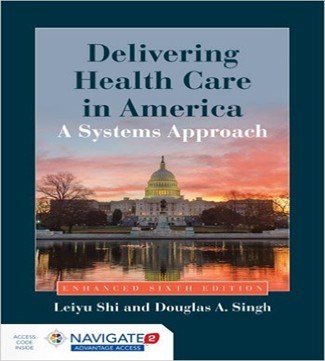Description
ISBN-10: 1284074633
ISBN-13: 9781284074635 978-1284074635
Chapter 3: The Evolution of Health Services in the United States
Multiple Choice Questions
1. Which of the following was the main force that prevented a government-run national health care program from becoming a reality in the United States?
a. Economic forces
b. Political change
c. Beliefs and values
d. Social forces
2. Medical care in preindustrial America had a strong _____ character.
a. scientific
b. professional
c. applied
d. domestic
3. The delivery of medical care in preindustrial America was governed mainly by
a. free market conditions
b. collusion among providers
c. professionalization of medical care
d. high barriers to entry
4. In the preindustrial era, _____ often functioned as surgeons.
a. butchers
b. tailors
c. clergymen
d. barbers
5. In the preindustrial period, what was the main role of dispensaries?
a. Dispensaries were affiliated with hospitals to provide charity care.
b. Dispensaries functioned as laboratories to conduct diagnostic tests.
c. Dispensaries provided basic medical care to ambulatory patients.
d. Dispensaries provided advanced medical treatments by private physicians.
6. Hospitals in the United States evolved from
a. almshouses
b. sickhomes
c. pesthouses
d. inns
7. What main purpose was served by an almshouse in the preindustrial period?
a. It was used to quarantine people who had contracted a contagious disease.
b. It provided free medical care and drugs to ambulatory patients.
c. It specialized in performing basic surgeries.
d. It performed general welfare and custodial functions.
8. What was the function of a pesthouse in the preindustrial period?
a. To house people who had a contageous disease.
b. To provide refuge to those who were threatened by pests.
c. To eradicate pests.
d. To treat contageous diseases.
9. Why in the preindustrial period most people could not afford the services of a qualified physician?
a. Professional fees were too high.
b. The economic cost of travel was too high.
c. Private health insurance was too expensive.
d. Most people relied on home remedies.
10. In the preindustrial era, asylums were built by ____ to accommodate patients with severe and chronic mental illness.
a. the federal government
b. private entrepreneurs
c. psychiatrists
d. the state governments
11. What was the main consequence of early proprietary medical schools, as opposed to state-sponsored schools, in the preindustrial era?
a. Standards were low.
b. The cost of medical education became too high.
c. Medical education became regulated.
d. Science and research became part of medical education.
12. Which of the following factors was particularly important in promoting the growth of office-based medical practice in the postindustrial period?
a. Urbanization
b. Educational reform
c. Science and technology
d. Dependency
13. When a profession’s services are generally accepted and are legitimized, they impart _____ to the profession
a. specialization
b. organized strength
c. cohesiveness
d. cultural authority
14. Cultural authority was conveyed to the medical profession mainly through
a. the development of the AMA
b. advances in medical science
c. patients’ dependency
d. licensing
15. Development of the hospital and ______ happened almost hand in hand in a symbiotic relationship between the two.
a. dependency of patients
b. growth of scientific knowledge
c. professionalization of medical practice
d. growth of AMA membership
16. Why did physicians remain independent of corporate settings even after the medical profession became well recognized?
a. Hospitals were unable to pay high enough salaries to physicians.
b. Physicians disliked salary arrangements.
c. Licensure laws had not yet been passed.
d. Physicians who took up practice in a corporate setting were castigated by the medical profession.
17. Organized medicine
a. Concerted activities of physicians through the American Medical Association
b. Affiliation of physicians with medical schools
c. Standardized practice of medicine
d. Unionization of physicians
18. The Flexner Report, published in 1910, reported on
a. standards for medical licensure in the US and Canada
b. standards of training in medical schools
c. rates of death in US hospitals
d. the state of medical specialization
19. The US Supreme Court decision in Olmstead v. L.C. directed US states to
a. deinstitutionalize people with mental illness
b. achieve parity in the delivery of physical and mental health services
c. increase funding for mental asylums
d. improve living conditions in mental asylums
20. In the US, public health and private practice of medicine developed separately because
a. Americans favored private delivery of medical care over public health.
b. physicians were skeptical of the government taking control of medical practice.
c. a public health infrastructure was lacking.
d. the practice of public health was not based on scientific methods.
21. The inception of _____ was used as a trial balloon for the idea of government-sponsored universal health insurance.
a. workers’ compensation
b. trade unions
c. public health
d. health care for the veterans
22. Initially, what was the main purpose of private health insurance in the US?
a. Prevent national health insurance from taking hold
b. Provide coverage for major illnesses
c. Provide comprehensive coverage
d. Compensate for loss of income during sickness and temporary disability
23. The Baylor Hospital plan, started in 1929, laid the foundation for modern health insurance in the US. This was a _____ plan.
a. managed care
b. contributory
c. comprehensive
d. prepaid
24. Why did the first Blue Cross plans cover only hospital care?
a. The AMA objected to the inclusion of physician services.
b. There was little demand for including other types of health care services.
c. Initial hospitalization was required in order to compensate a beneficiary for loss of income.
d. The Blue Cross commission determined that including other types of health care services would be unprofitable.
25. During the World War II period, health insurance became employer-based because of
a. endorsement from Blue Cross and Blue Shield plans
b. wage freezes
c. disputes between labor and management about the cost of health care
d. union demands
26. During the World War II period, the US Supreme Court ruled that
a. health insurance must be employer-based
b. all large employers must provide health insurance to their employees
c. health insurance could be part of union-management negotiations
d. health insurance must cover major medical expenses
27. What was the main reason for initiating national health care in countries such as Germany and England?
a. Improve the health of industrial workers
b. Ward off political instability
c. Provide access to emerging technology
d. Relieve poverty
28. Who was the first American president to make an appeal for national health insurance?
a. Theodore Roosevelt
b. Franklin Roosevelt
c. Harry Truman
d. Bill Clinton
29. Historically, which interest group was the most powerful in opposing national health insurance during the 1900s?
a. Trade unions
b. Employers
c. The American Medical Association
d. The Republican party
30. On what grounds have middle-class Americans generally opposed proposals for a national health insurance program?
a. Higher taxes
b. Government intervention
c. Erosion of personal freedoms
d. Cost of health care
31. Medicare and Medicaid programs were created for population groups regarded as
a. elderly
b. vulnerable
c. underinsured
d. politically active
32. How has Medicaid created a two-tier system of medical care delivery in the US?
a. Many physicians do not serve Medicaid patients.
b. Only the poor are insured under the Medicaid program.
c. Funding for the program is shared by both federal and state governments.
d. The program is heavily regulated.
33. The private medical sector in the US has been heavily regulated by the government mainly because
a. most health care services are in private hands.
b. most people served by the medical establishment are in a position of dependency.
c. the government has an interest in monitoring quality for all Americans.
d. the government finances Medicare and Medicaid.
34. Physicians and hospitals in the US began consolidating and integrating mainly in response to
a. increased government regulation
b. pressures to contain costs
c. the growth of managed care
d. the demand for higher quality
35. E-health has resulted in
a. patient empowerment and a dilution of their dependent role.
b. loss of control by physicians over health care delivery.
c. increased government regulation.
d. increased corporatization of health care delivery.
36. Which of the following is not true about the Patient Protection and Affordable Care Act of 2010?
a. Not a single Republican voted for the legislation
b. Most Americans supported the legislation once they found out what was in it
c. The legislation was supported by the AMA
d. The US Supreme Court upheld the individual mandate
(Answers: 1c, 2d, 3a, 4d, 5c, 6a, 7d, 8a, 9b, 10d, 11a, 12a, 13d, 14b, 15c, 16d, 17a, 18b, 19a, 20b, 21a, 22d, 23d, 24a, 25b, 26c, 27b, 28c, 29c, 30a, 31b, 32a, 33d, 34c, 35a, 36b)
True or False
1. In the preindustrial period, Europe was more advanced than the US in medical science.
2. When hospitals first emerged in the United States, they were used primarily by the wealthy.
3. In the preindustrial era, much of the medical care in the US was provided by nonphysicians.
4. As the health care delivery system developed in the US, it emphasized specialization over primary care.
5. As the health care delivery system developed in the US, right from its inception primary care physicians were assigned a gatekeeping role.
6. When bills for compulsory health insurance were introduced in several states, they were opposed by labor unions.
7. When bills for compulsory health insurance were introduced in several states, they were supported by American employers.
8. Middle-class Americans have historically opposed proposals for a national health insurance program.
9. Wage freezes during World War II helped promote employer-based health insurance in the United States.







Reviews
There are no reviews yet.